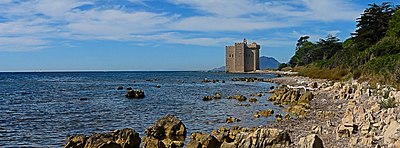aplayer1286477363" width="492">
Situated on an island of the same name, now known as that of Saint-Honorat, about a league from the coast of Provence, in the Department of the Maritime Alps, now included in the Diocese of Nice, formerly in that of Grasse or of Antibes. It was founded at the beginning of the fifth century by St. Honoratus. This saint lived there at first the life of a hermit, but followers soon gathered around him. They came from all parts of Roman Gaul and even from Brittany. During the fifth, sixth, and seventh centuries, the influence exerted by the abbey was considerable. The presence of the Saracens in Provence made the monastic life impossible or precarious for two centuries
. The abbey was restored in the eleventh century, and a new era of prosperity began. It was given many estates and churches in the neighbouring Dioceses of Antibes, Aix, Arles, Fréjus, Digne, Senez, Vence, Nice, Ventimiglia, etc. The popes, the counts of Provence, and the kings of France bestowed on it many privileges. The monks were obliged during the Middle Ages to take an active part in defending the coasts against incursions of the Moors of Algeria. A monumental tower, built as a place of refuge, is still standing.
The abbey was an important strategic position in the sixteenth and seventeenth centuries during the Franco-Spanish wars. The commendam was introduced at Lérins in 1464. There was a crying need for reform. The monks were placed under the Italian Congregation of St. Justina of Padua (1515), which brought about for the monastery a long era of prosperity, both spiritual and material. The subsequent union with the French Congregation of St. Maur (1637) was of brief duration. A century later the monks were obliged to leave the Italian congregation to become a part of Cluny. The decline had already commenced; it steadily increased until the time of suppression (1791). The religious had followed the Benedictine Rule from the seventh century onwards.
During the first period of its history, Lérins gave to the Church celebrated bishops and writers. Through them the abbey played an important role. Such were St. Honoratus, his successor St. Hilary, and St. Caesarius, Archbishops of Arles; St. Maximus and Faustus, Bishops of Riez, St. Eucherius, Bishop of Lyons; St. Lupus, Bishop of Troyes; St. Valerianus, Bishop of Cimiez; St. Salvianus, Bishop of Geneva, St. Veranus, Bishop of Vence; and the celebrated Vincent de Lérins. The presence of so many writers in one monastery has given rise to the belief that it was a theological school, which, however, it was not. Lérins had a reputation for learning, but it had no organized teaching body. The part given to the monks of Lérins in the editing of certain legends by M. Dufourcq is strongly contested. We find no writer of note from the seventh to the thirteenth century; after that came the troubadour Raymond Féraud; then Giovanni Andrea Gregorio Cortese, who died in 1548; Dionysius Faucher, who died in 1562; the historian of the abbey, Vincent Barralis, who died at the beginning of the seventeenth century
.
Besides these writers and bishops, Lérins had also many monks of great sanctity; we must mention St. Antonius; the holy abbot and martyr Aigulf, who introduced the Benedictine Rule about 661; Abbot Porcharius II, who was massacred with his monks by the Saracens about 732. St. Patrick, the apostle of Ireland, lived some time in the monastery, as well as St. Cassian, founder of the monastery of St. Victor at Marseilles.
The abbey was restored by the Congregation of Sénanque in 1868. They preserved whatever remained of the ancient monastic buildings, that is to say the cloister, the refectory, and the chapter hall, which they enclosed in the new abbey. The fortress, of which the construction was begun in 1073 as a place of refuge in case of sudden attack, is fairly well preserved. The records, as well as the manuscripts of the old library, are in the archives of the Maritime Alps at Nice. Few monasteries have a history to which so much attention has been devoted as that of Lérins.
The monastery of Lerins is linked in the twentieth century with the foundation of another monastic institution, the Brothers of St Jean. (Click here for an account of this important event.) It all goes to show how God blesses us when we are generous to others. I have been told that one of these novices that they so kindly accepted to train was a musician who helped them with new liturgical music. Perhaps that is the music we hear in one of the videos.










No comments:
Post a Comment